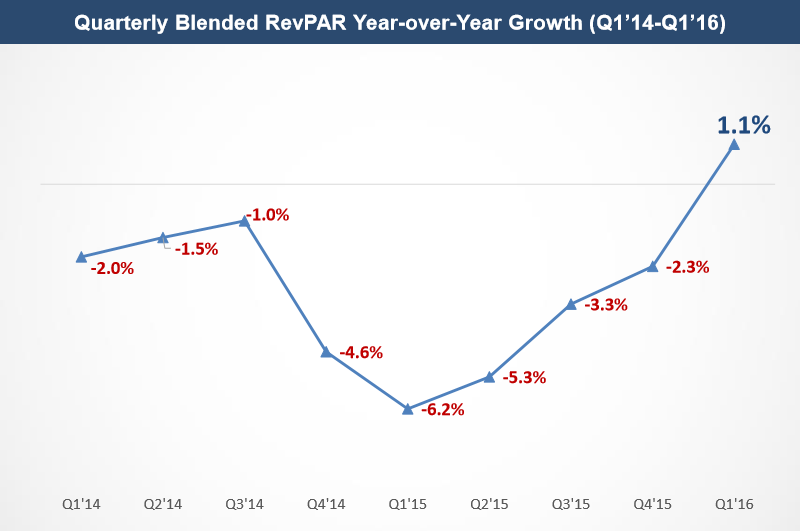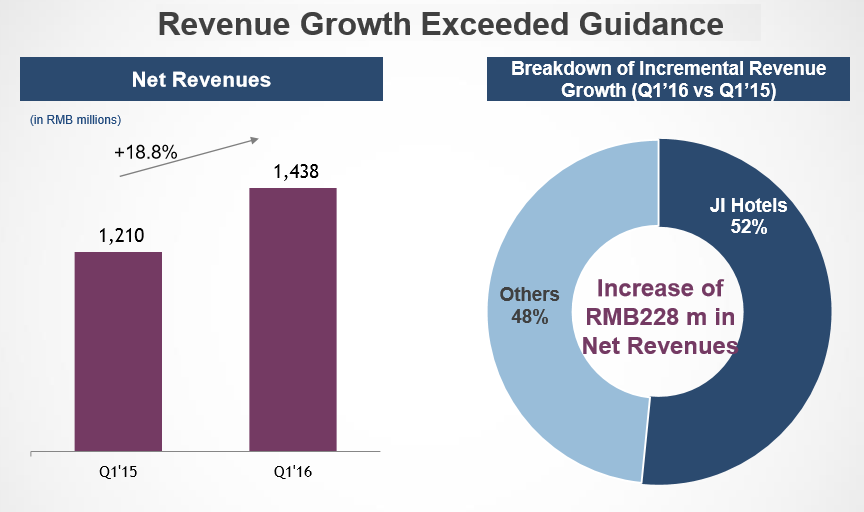ChinaTravelNews, Ritesh Gupta - Quarter after quarter hotel companies in China have been increasing their appetite for risk, as they have chosen to change the complexion of the lodging industry here with their aggressive expansion and multi-brand business strategy.
It’s one thing when one of the players, China Lodging Group, states that the team is replicating the trail of Marriott in a much shorter time span (comparing Marriott’s growth trajectory and expansion over six decades with China Lodging’s relatively short history of 11 years).
But does the group have in them to prove strong innovation capability that in reality drives an underlying strong performance?
China Lodging stated that their Q1 financial performance certainly gave ample indication of the same.
A major key performance indicator in this context was the group’s blended RevPAR growth that turned positive.

Jenny Zhang, chief executive officer, China Lodging Group mentioned that the blended RevPAR turned positive during the quarter as the group’s geographical mix started to stabilize and “our mix shifted towards an increased proportion of midscale and upscale hotels”.
The improvement in blended RevPAR was also driven by strong performance of three brands. The same-hotel RevPAR grew 10% for Ji Hotel, 8% for HanTing 2.0, and 6% for Hi Inn.
As for whether demand has picked up in lower-tier cities and translated into meaningful RevPAR contribution, Zhang said the group started noticing weakness in the lower-tier cities a couple of years ago. So as to how China Lodging responded, she said one of the decisions the team took was to shift its investment focus, for both leased hotels and manachised hotels, to tier 1 and tier 2 cities.
“So we strictly control and maintain more than 70% of our portfolio currently are still in tier 1 and tier 2 cities,” explained Zhang.
“We are also (constantly) innovating into more brands which can cover different type of properties and different segments of customers that enables us to deeply penetrate into the bigger markets,” she said. “We are also studying different business models and marketing and selling tactics that can be applicable to tier-3 and tier-4 cities. And we expect those tactics to start to bear some fruit in second half next year.”
In Q1, the team welcomed five brands ranging from economy to upscale segments through their strategic alliance with Accor Hotels.
Overall, the Q1 performance from China Lodging lends a strong credibility to the sector.
Hotel companies in China have been exuding confidence over the past few quarters despite the taxing macroeconomic external environment they have had to operate in. The plans can backfire, too, considering the limited operating experience in managing say more than 10 brands, or the same going awry especially with huge pre-opening expenses that are incurred during the development stages. In case of China Lodging, the pre-operating expenses as a percentage of net revenues decreased by 1.4 percentage point from a year ago. This mainly results from fewer leased hotels in the pipeline. Also, the group is forging ahead with rapid expansion.
In Q1, the number of newly-added hotels were 226, indicating y-o-y hike of of 24%.
“We applied both organic and non-organic approaches in our expansion. Among the newly added hotels, 129 hotels are under our own brands and 97 are under Accor brands,” said Zhang.
It also needs to be highlighted that overall China Lodging has invested RMB 130 million into apartment and shared office sectors. The team believes that apartment and shared office sectors “are still at early stage, highly fragmented but with sizable market potential.” The group is in a position to leverage their expertise from hotels, such as brand building, network development and operation, and the plan is work out “synergy among hotel, apartment and shared office, in terms of site acquisition and yield management”.
The group stated that they currently have abundant funding resource for expansion, with capital allocation being supported by continuing strong cash flow generation.
Standout performers
The group’s Q1 net revenues grew 18.8% year over year, beat guidance of 14-15% growth.

Around 52% of the incremental revenue growth was accounted by Ji Hotel.
HanTing Hotel has a pipeline of 271 hotels and JI Hotel, a leading midscale hotel brand, has 105 hotels in the pipeline.
Also, the upgraded HanTing 2.0 version of the group’s economy hotel product has delivered noteworthy performance. As explained in our previous report, this new initiative has been taken to improve operational efficiency and better offering for frequent travellers.
“Over 18% of our HanTing revenues were contributed by HanTing 2.0 model at the end of the first quarter. We expect the new model will account for 35-40% of our HanTing inventory by the end of 2016,” shared Zhang. She added, “…most of the new hotels opened in 2015 and all of new HanTing opened in 2016 are going to be under this new design.” When enquired during the company’s Q1 earnings call about investment incurred and the return on investment as far as HanTing 2.0 is concerned, she said, “…in terms of investment per room, currently it’s approximately RMB70,000 per room for a new hotel, and the RevPAR is meaningfully higher than our older design. We have seen different numbers at different level cities, but typically the range is…could be anywhere from RMB10 to RMB30, in terms of RevPAR improvement. So the return on investment currently is very attractive.”
As for the major change that the brand has undergone, it is mainly on the design side.
The color combination has evolved from the dark red to light gray and blue, to lend a “younger feeling, more cheerful” one. The team also went ahead with a new model of fully built-in bathroom into HanTing 2.0.
“So it gives people a much better experience, especially for the younger customers,” said Zhang.
Boosting direct sales
In addition to differentiating HanTing and gearing up for its fast expansion, the third main area of focus for 2016 is going to be direct sales.
In 2015, 90% of the total room nights were sold through China Lodging’s own sales platforms and the remaining 10% of room nights through intermediaries. But this figure went down in Q1, with 87% or so of room nights being sold through own channels. The travel agents channel chipped in with increased share due to “increase utilization of lower costs OTA sales channels during the low season”.
On the positive side, at the end of Q1, the company’s loyalty program had approximately 55.3 million members. This group contributed more than 85% of room nights sold during the first quarter of 2016. At the end of 2015, the HuaZhu Club had more than 49 million members. In 2015, more than 80% of room nights were sold to the HuaZhu Club members.




